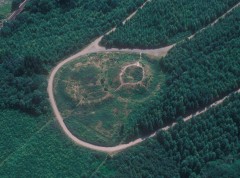Overlooking the Taw Valley, at the northern end of Heywood Wood, stand the remains of an early medieval motte and bailey castle. Motte and bailey castles are medieval fortifications introduced into Britain by the Normans. This type of castle was made up of an artificial mound, or motte, on which was built a wooden or stone structure known as a keep. Next to this at least one bailey, a fortified embanked enclosure containing additional buildings, would be built. Although many were occupied for only a short period of time, motte and bailey castles continued to be built and occupied from the 11th to the 13th centuries, after which they were superseded by other types of castle.

The castle at Heywood possibly took the place of an earlier castle some 500 metres to the south in the grounds of Heywood House, on the steep valley side above the River Taw. An alternative theory is that both date to the 1130s and 1140s, and were built during the civil war between Matilda, daughter of Henry I, and his nephew Stephen.
Heywood Wood is owned by the Forestry Commission and the castle is a short walk from the car park.
For more information, see the Historic Environment Record information about this site on Heritage Gateway.